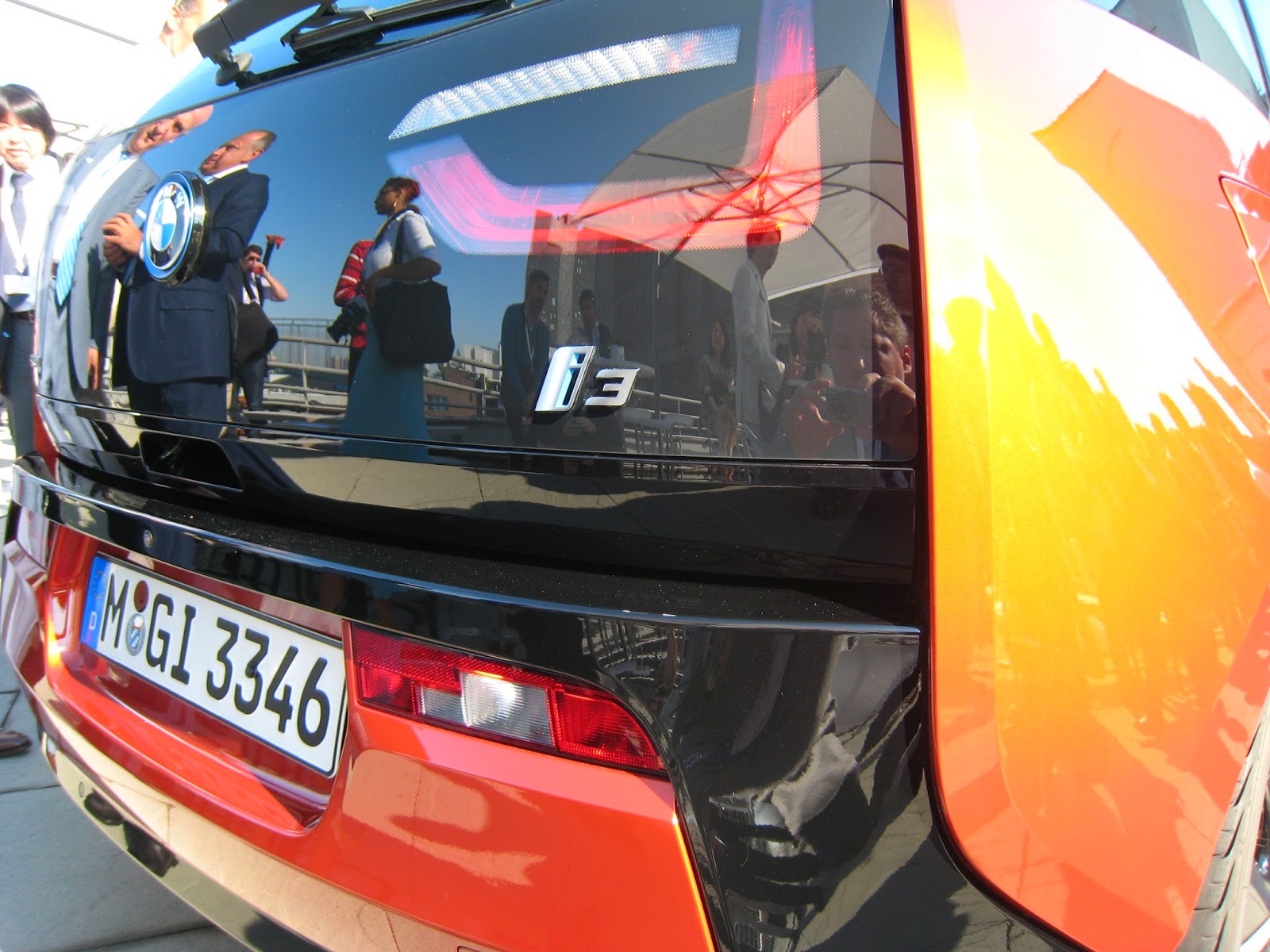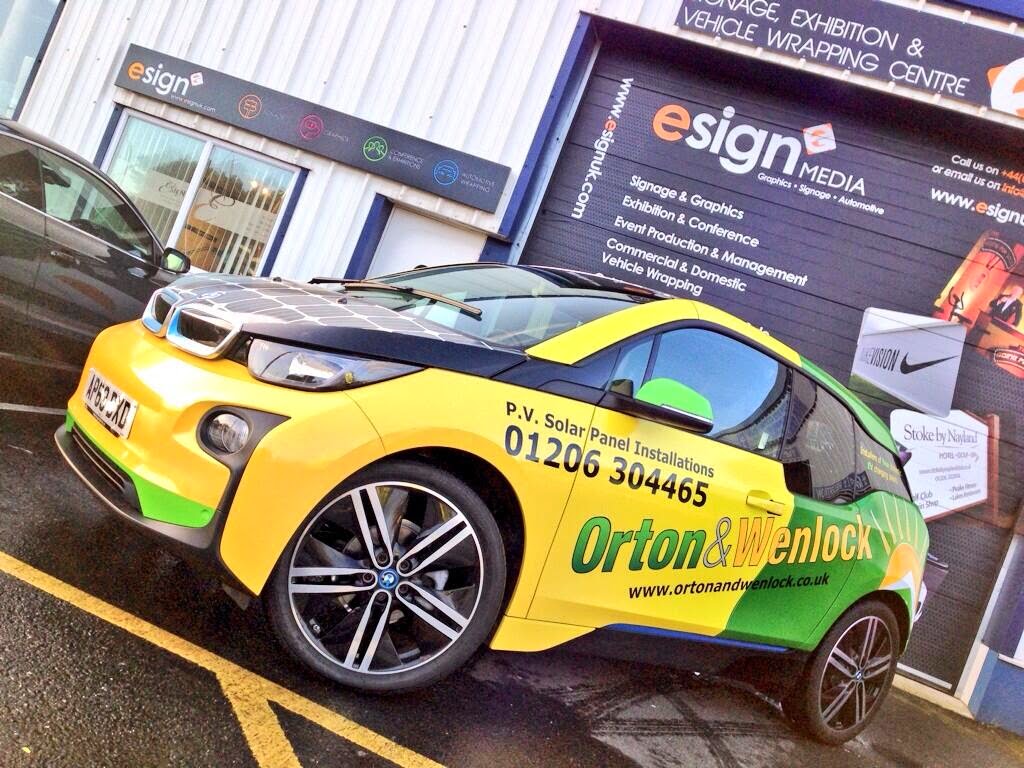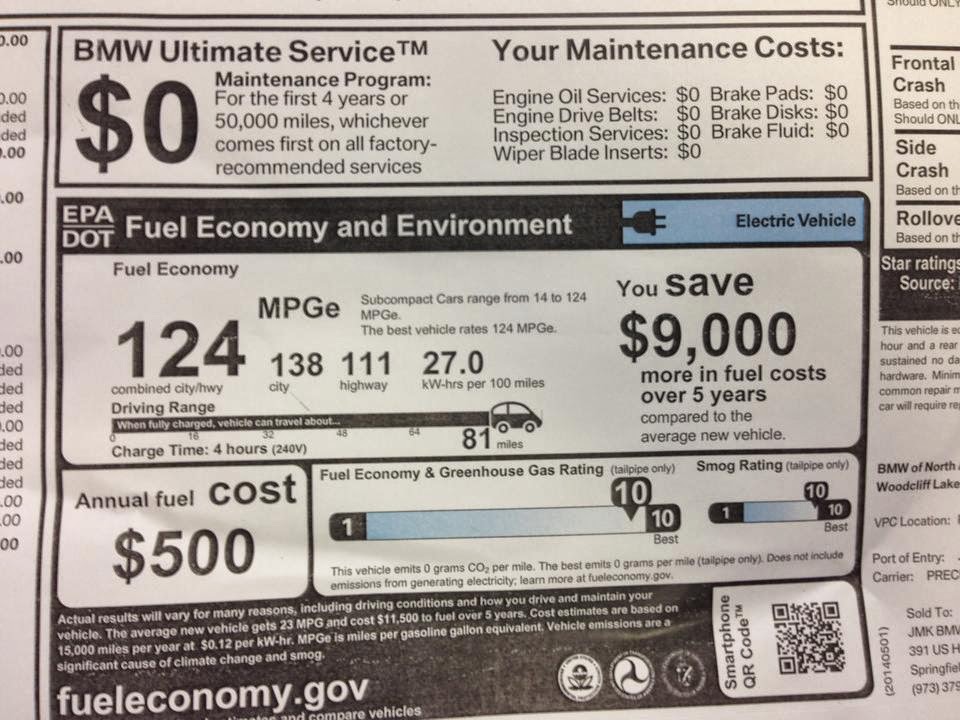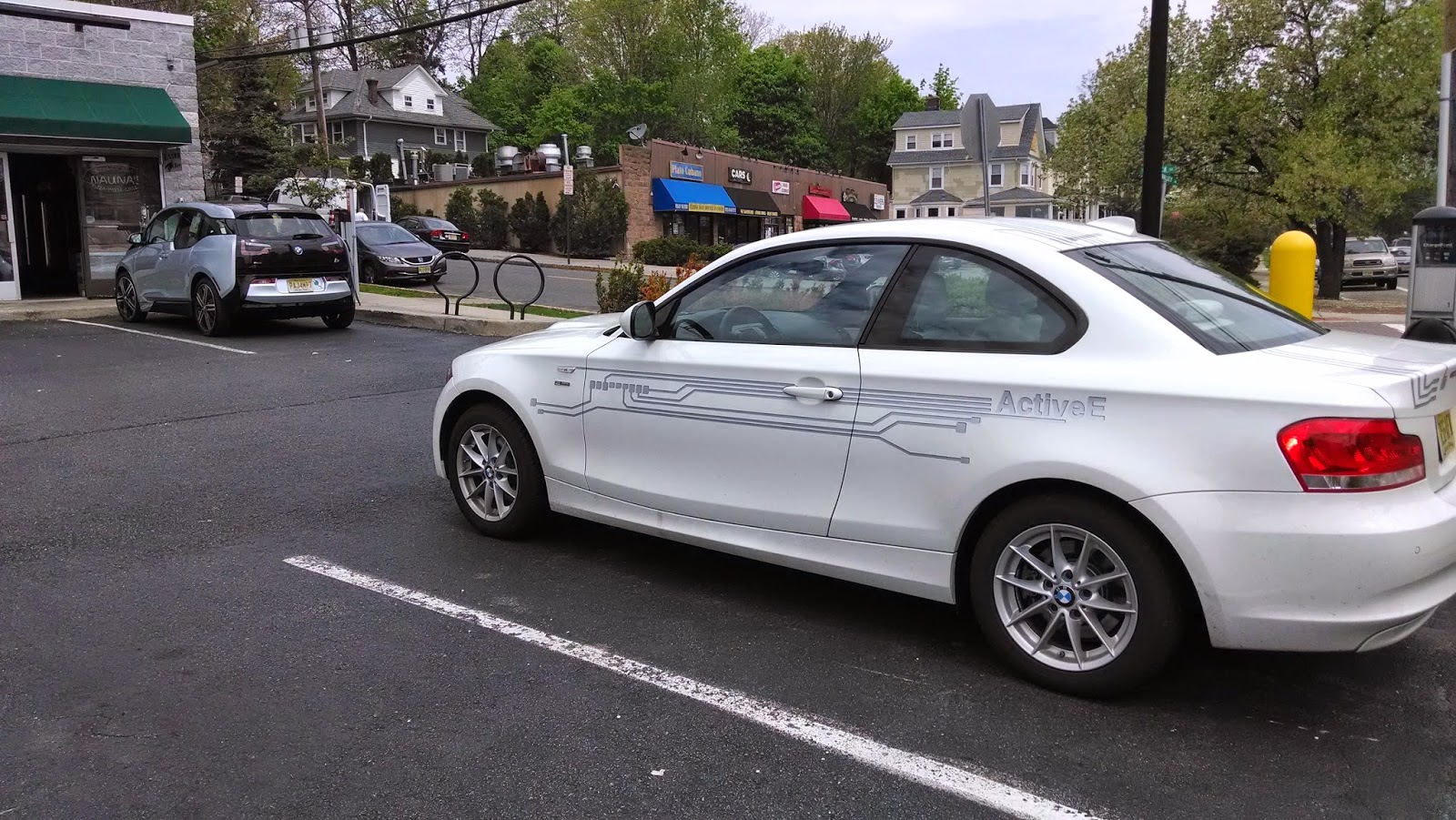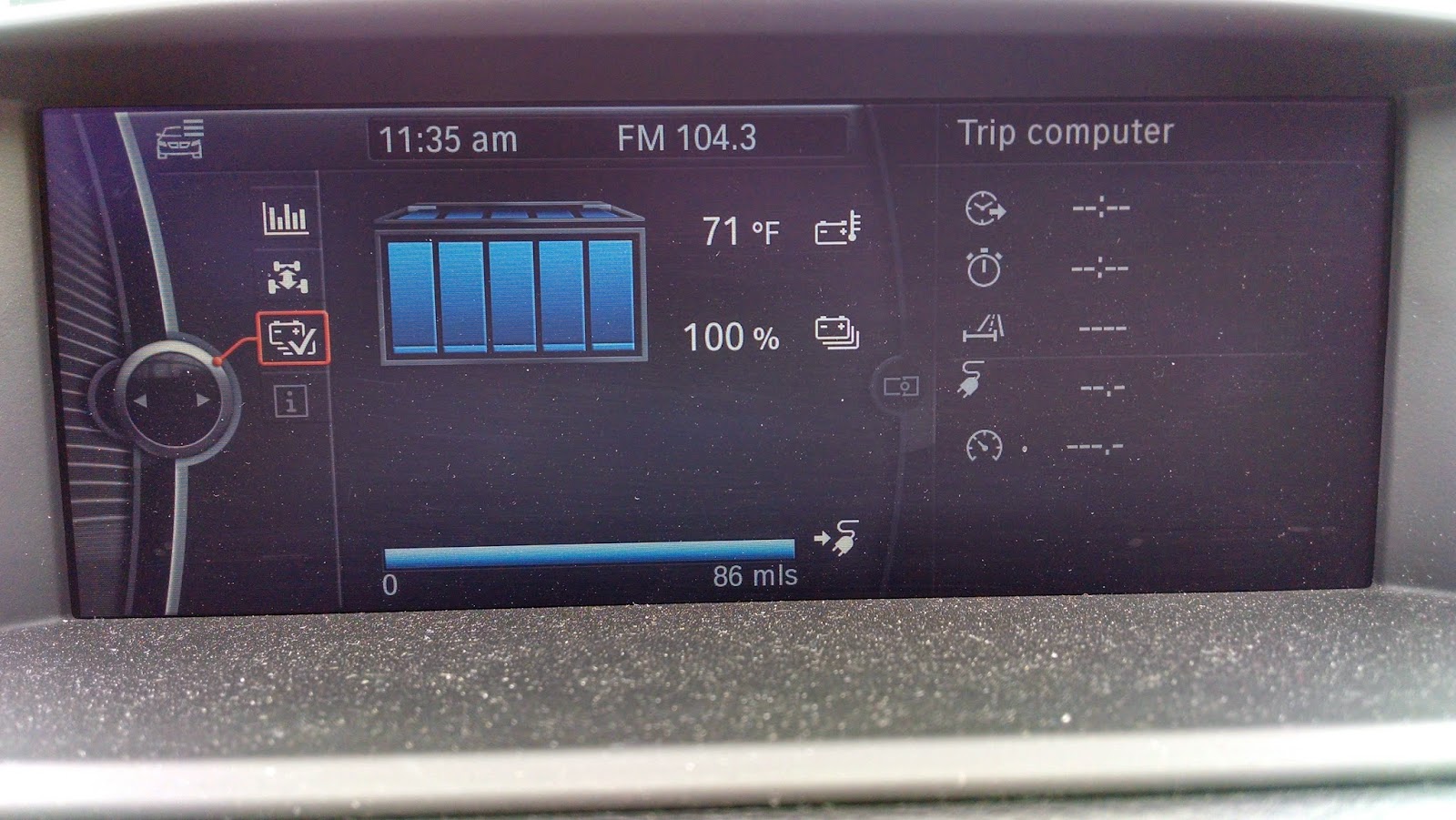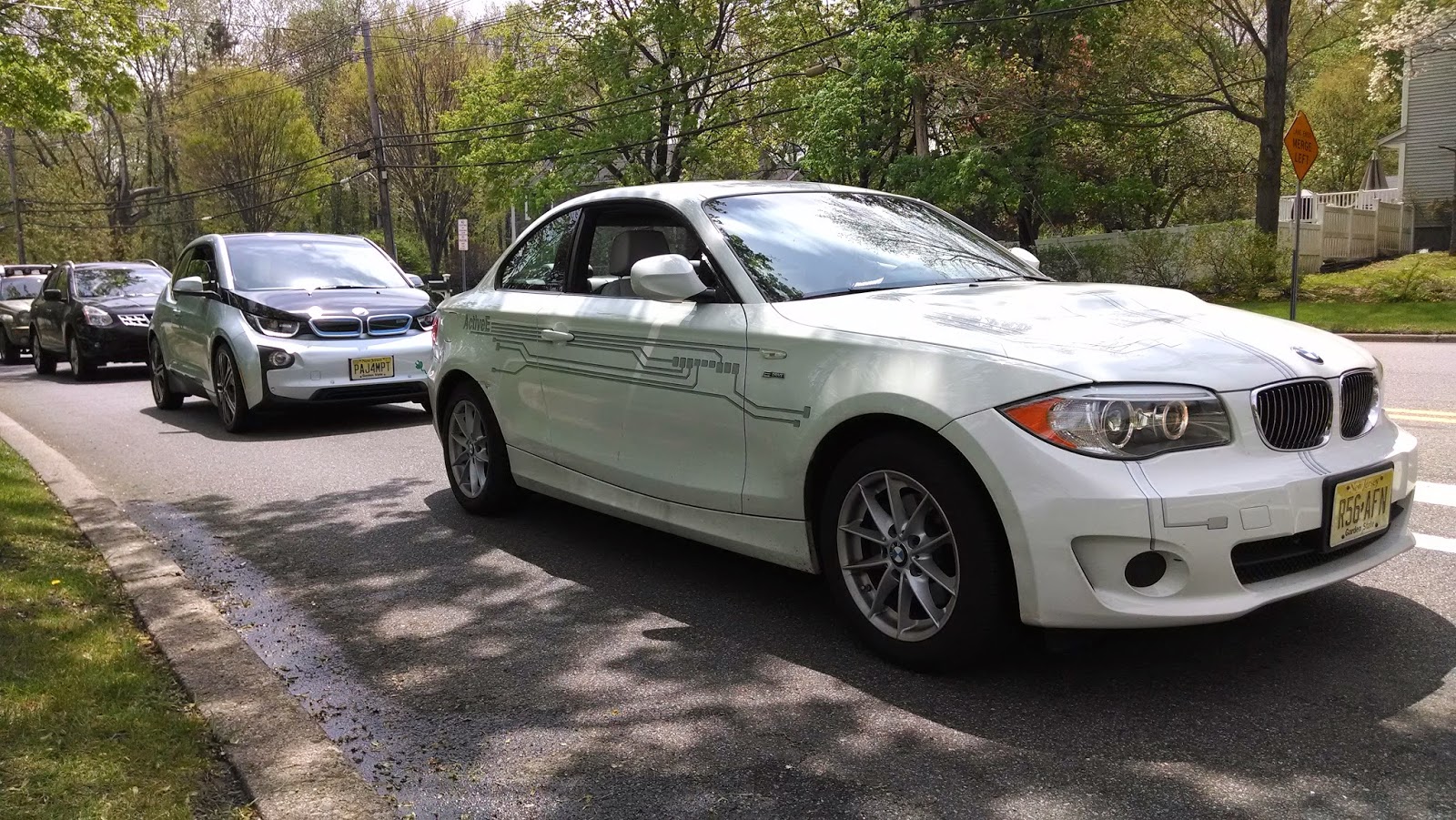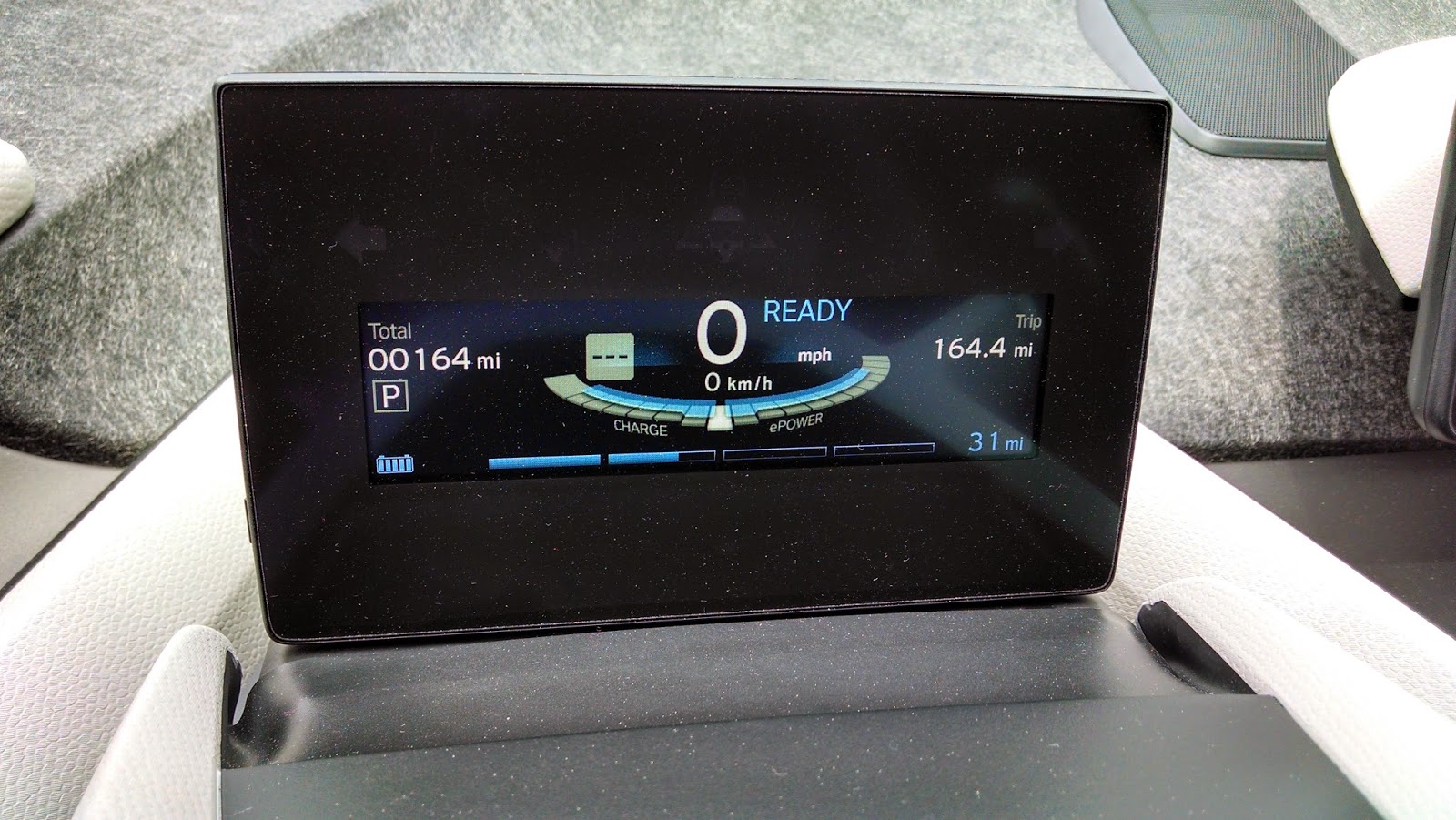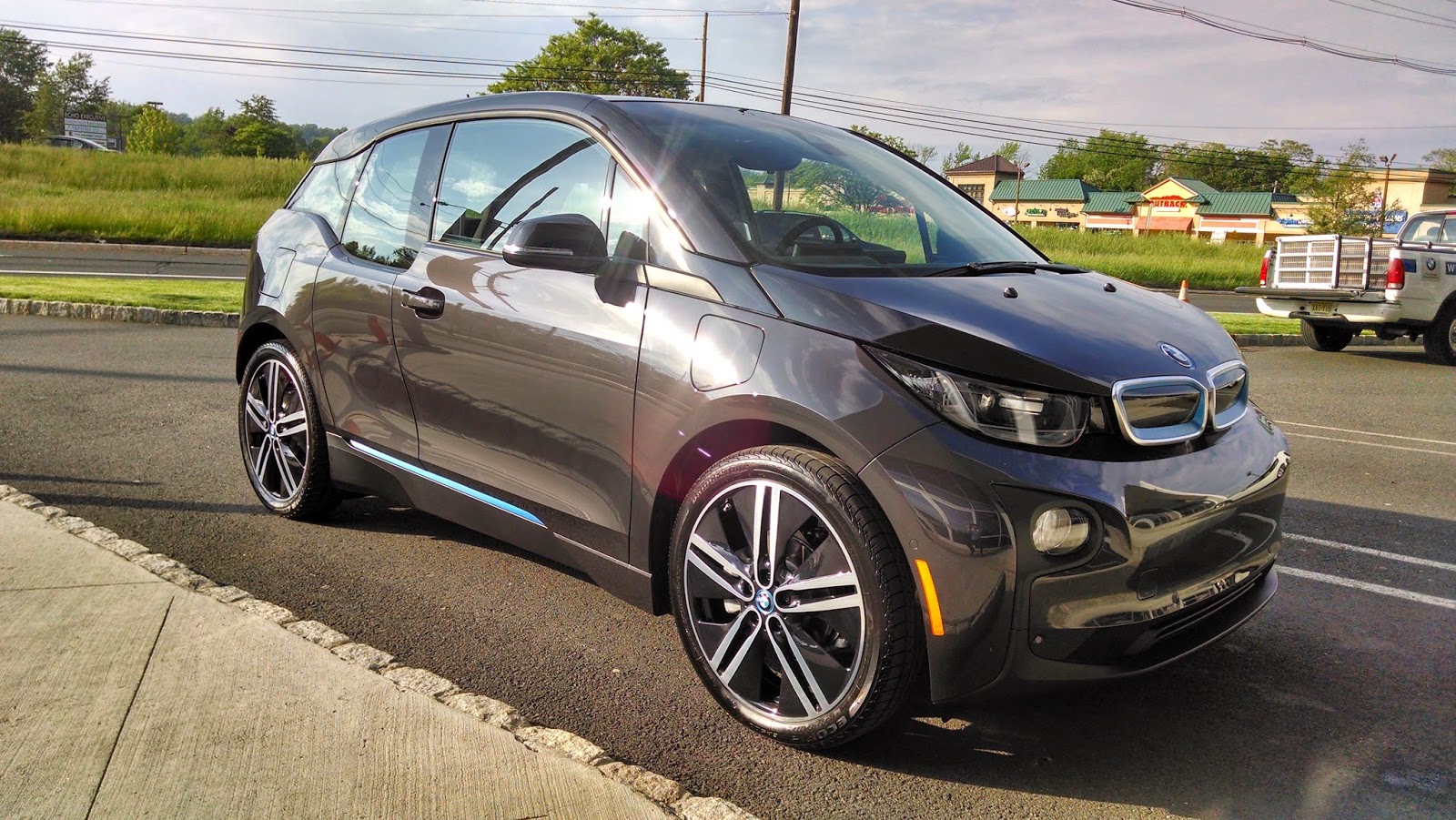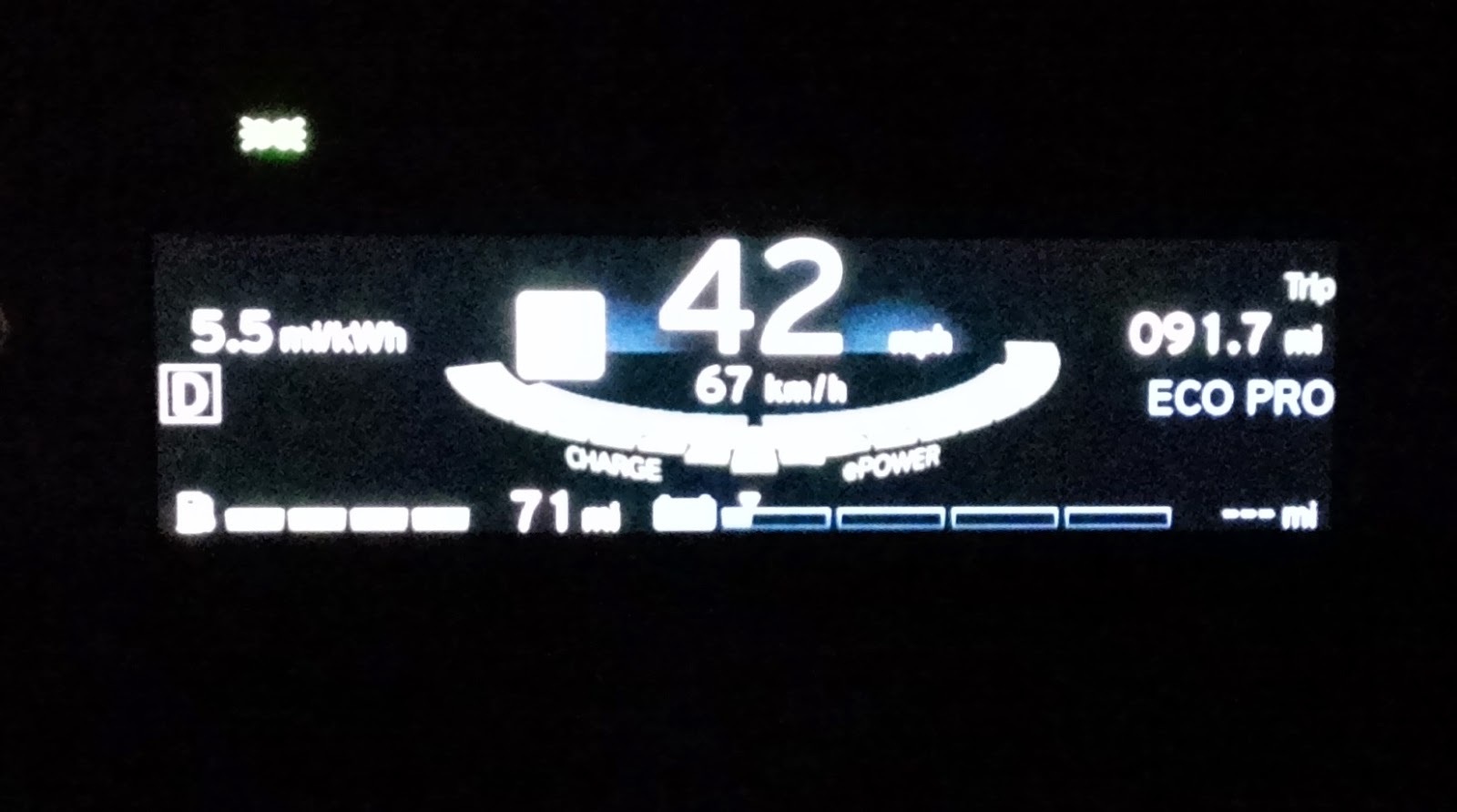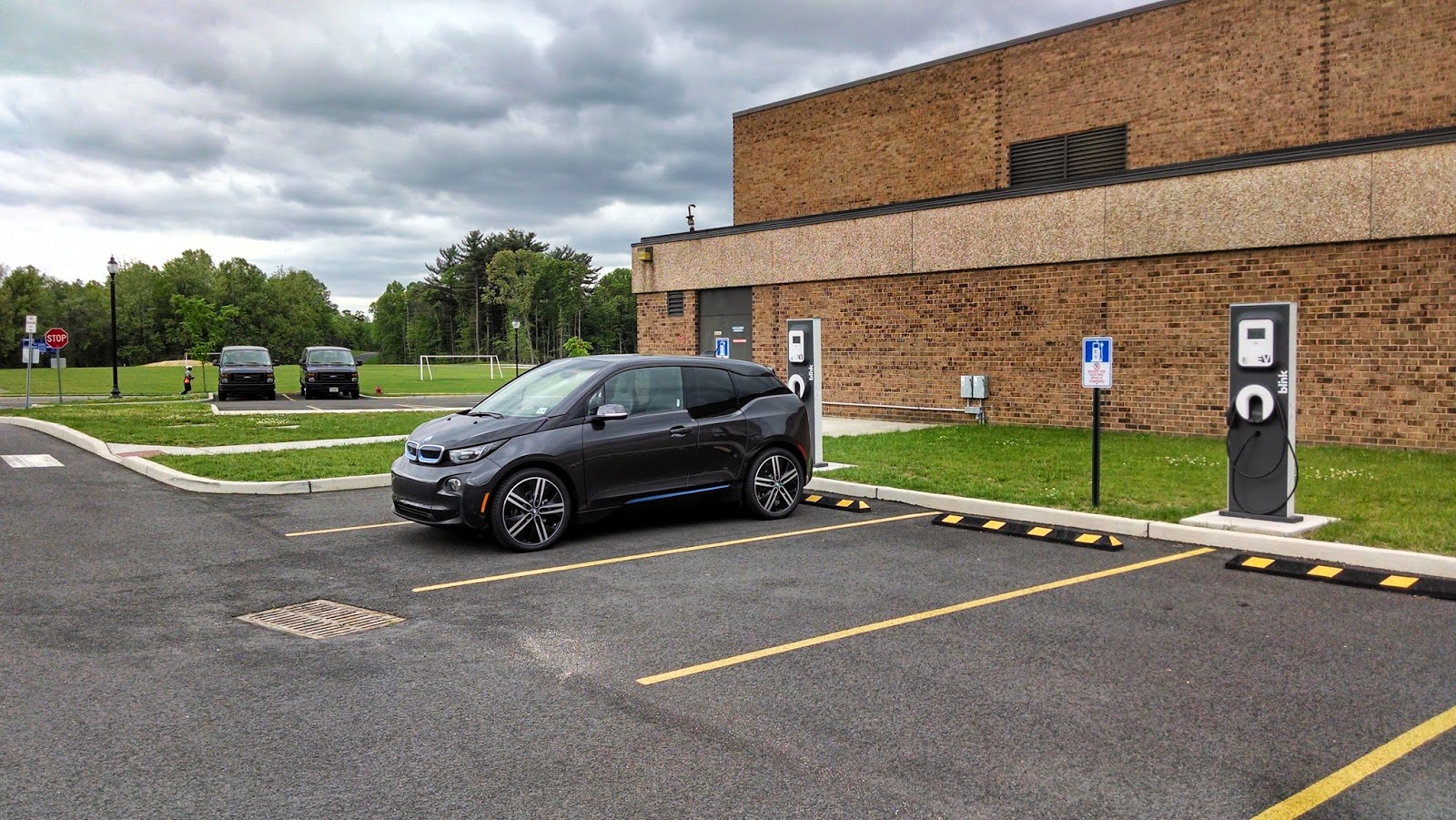![]() |
| Charging up at Hampton Inn in Turnersville... but for how long? |
Ever since the i3 colors were announced, I had thought about doing a custom color wrap for my i3. The colors offered just weren't very inspiring and other than the Solar Orange, they were all white and shades of grey or silver. I chose the Laurel Grey because I liked how it made the car look more like one solid color. It minimized the "Black Hand" design that BMW used to try to give the appearance that the i3 is slimmer than it actually is. It's a short car that is tall, and definitely has unusual lines and BMW believed that using black on the top surfaces would make it look less "chunky". I also liked the idea of having a custom color so my car would be easily identifiable in pictures. I'll be writing i3 reviews for quite a few websites, and having my car a distinct color will let the readers know immediately that it's my car they are looking at.
![]() |
| Once I got to see my car in person I realized how much I really do like the Laurel Grey |
That being said, once I got my car I realized how great the Laurel Grey looks, especially with the Frozen Blue accents and I started having second thoughts about doing the wrap. I decided to go through with it anyway because I really like the idea of having a distinctive color that no other i3 has. Plus, when I take it off it will feel like I got a new car again because the wrap protects the paint perfectly underneath. Since I'm wrapping a new car the paint will remain pristine and in a year or so when I decide to take it off I'll be able to enjoy the Laurel Grey with Frozen Blue color scheme.
After doing some research I decided to get the wrap done at
Designer Wraps in Millville, NJ. It's about a 130 mile trip from my house and while there are closer wrap shops, I want to get it done somewhere that has a great reputation and has been doing wraps for a long time and Designer Wraps fit the bill. So I plotted the trip and since the wrap takes 3 or 4 days to complete, I told my wife I'd need her to drive down with me separately so I could drop off the car and we'd drive back together. The funny thing about it is she initially said, "How long will that take? Is there a charging station along the route where you can stop and charge?" She momentarily forgot I have the range extender on the i3 so she was thinking this would be an all day road trip. After driving pure EVs for five years now, she had been conditioned to think a long trip meant 80 miles or so of driving, and then four or five hours of charging in order to continue. After staring at her and smiling for a few seconds, she realized her error and we just laughed. Only two days of ownership in and the REx is immediately a game changer.
Then I realized I had also overlooked something, but not anything with regards to the car though. We were planning on driving down early on the morning of Saturday, May 24th, and that turned out to be the Saturday of Memorial Day weekend. If you live in New Jersey, you know how bad traffic is going south on the Parkway or the Turnpike during either Memorial Day or Labor Day weekends, as tens of thousands of people migrate to the Jersey Shore for these two weekends that bookend the summer. A two and a half hour drive could easily take five hours under these traffic conditions. So we came up with plan B. We would drive about 100 miles late Friday night which would get us passed the major traffic areas, stay in a hotel and continue on the next morning.
Since we would be spending the night, I figured I might as well find a hotel that would let me plug in 120v while we were there. After all, the goal is to drive on electric as much as possible, even with the REx and an overnight stay would give me enough range to make the final 40 miles or so without the REx kicking on. After making some calls, I found an
Hampton Inn in Turnersville, NJ that said I could plug in and it was just about perfectly along our planned route. The hotel was about 100 miles into the trip and we would then be 40 miles from Designer Wraps. An overnight charge would give me just enough to complete the trip the next day without the range extender. If I really wanted to, I could have probably found a hotel that was only halfway there, and tried to complete the entire trip without the REx, but then I would have needed to find a L2 240v EVSE, as overnight charging on 120v wouldn't have been enough to fully replenish an empty battery. It just wasn't worth the trouble, and if everything worked out, the 140 mile trip would end up with me using only a little more than a half a gallon of gas and without any inconvenience.
![]() |
| I drove nearly 90 miles before the REx came on |
It was raining heavily for most of the drive there so I wasn't expecting to beat the car's predicted 75 mile electric range but I did. I was shocked when I drove 89 miles, mostly at speeds of 60 to 65 mph but occasionally faster, before the range extender turned on to hold the battery charge for the final 9 miles. There was traffic so we did occasionally drive for a while at about 50 to 55 mph and I did activate Eco Pro mode about halfway into the trip. I didn't really do so to extend my range because driving at constant highway speeds requires a certain amount of energy regardless of what mode you are in and I don't think Eco Pro will really help out much at all with this kind of driving. I really just wanted to see if there was any noticeable difference in the driving behavior and found out something very interesting that I haven't seen reported anywhere before. When driving in Eco Pro mode the car tries to keep you from driving faster than 75 mph. If you are in Eco Pro and accelerating, when you hit 75 mph the car holds at 75 mph momentarily, and in order to go faster you need to really push the accelerator further than you would normally have to in order to continue accelerating. It's kind of like the car is coaching you to not exceed 75 mph because of how inefficient it is to drive at that speed. Once you continue to push the pedal further, it realizes you really do want to go faster and it takes off with a bit of a surge. I then tried this in Eco Pro+ mode and found out it does that same thing at 55 mph in that mode. This is a nice feature to "remind" you that driving faster will consume more energy than you may want to. This only happens in Eco Pro and Eco Pro+, and not in the default Comfort driving mode.
![]()
We arrived at the Hampton Inn around 1:00am with 98.1 miles on the trip odometer, and only the last 9 with the range extender in operation. The gas gauge barely moved and looked like I only used about 1/12 of the tank. The gas gauge showed 62 miles of range remaining and if that held true, then I would have had 160 mile range total; 89 on pure electric and 71 on gas.
![]() |
| Plugged in at Hampton Inn |
![]()
After checking in and confirming it was OK with the front desk attendant I went outside and pulled my car to the front door where there were two brand new 120V outlets, one on each side of the front entrance. I checked around the rest of the building and didn't see any other outlets that were assessable. I'd prefer not to be plugged in right in front and draw attention, but it was the only outlet available and I was able to pull over to the side and well passed the entrance so the car wasn't in anyone's way. I got up around 7:30am and checked my app to see the state of charge and noticed the SOC was at 30% but that the car was no longer charging and had a "charging error" at 5:07am. I went out to the car and saw it was unplugged from the wall so I plugged it back in and went to the front desk to ask if there was a problem. It was a different person than when we checked in and she told me the owner came in and unplugged the car. I explained to her that I called ahead to ask if I could plug in and was told it wouldn't be a problem and that I told the person the night before that if there was indeed any problem to please call my room. I also asked if I could speak to the owner was was told no, I could not. With that I told her that I plugged the car back in and if the owner has a problem with it to please call my room as I would like to discuss this with them.
![]()
After about 15 minutes my smartphone app notified me that the car had another charging error so I went back down to try to straighten out the situation one more time. Again the car was unplugged so I went to the desk to ask to speak to the owner and again was told they are unavailable. So there was nobody that would even address the situation with me. I then very politely informed the person at the desk that I'd be contesting the charge on my credit card and refusing to pay for the one night stay as well as contacting Hampton Inn customer service. Hampton Inn boasts the "100% Hampton Guarantee" that promises "If you are not satisfied, we don't expect you to pay". Honestly, if someone would have just talked to me and given me any reason, even if it wasn't a valid reason like "Due to insurance concerns we can't let you charge" or "Other guests were complaining that you are getting free fuel but they aren't" I would have accepted it and agreed to pay my bill. While I wouldn't be happy and would likely write to Hampton Inn asking them to consider changing policy, I wouldn't have evoked the Hampton Guarantee and told them I will be writing customer service and asking to be refunded. The fact that nobody there had the decency to even talk to me about it, or call my room to explain that they needed to unplug my car tells me they don't care about offering acceptable hospitality. If you don't fit into the box of what services they expect to provide for their typical guest, then you are out of luck and they won't even discuss the issue with you, and that's very unfortunate. I understand this is new territory for many hotels, and that I shouldn't feel entitled to charge my car wherever I want to. However I did ask first and I did make it clear that if there was a problem to please call my room to discuss it with me. I would never lose my temper or get confrontational with anyone in this kind of situation. I believe the early adopters need to be ambassadors for plug in cars, paving the way for the rest and we need to do our best to educate the uninformed as to why this is indeed a better path for us all. I will certainly be in touch with Hampton Inn's customer service this week, and try to encourage them to proactively adopt a charging-friendly policy for all of their locations. So perhaps something good will come us this unfortunate incident.
![]() |
| Will Hampton Inn honor their guarantee? I'll find out soon |
![]() |
| Charging at Camden County College |
Realizing I didn't have enough charge to make the final 40 miles to Designer Wraps, I pulled out my phone and looked up the charging stations in the area. I found that Camden Community College was only a few miles away and they had two level 2 EVSEs. So we headed over there, found the two Blink stations, plugged in and went out for a bite to eat. After breakfast we went back to the hotel, got our belongings and went to check out. By then there was a new person at the desk and when they asked if everything during our stay was OK I told them it wasn't and explained the charging issue. She seemed a bit confused about what to do but didn't offer any help or even to get a manager so I just thanked her and informed her that we'd be contacting Hampton's customer service to take up the issue with them.
![]() |
| Giving a quick i3 seminar! |
We headed back to get my car and when we arrived we were greeted by a security guard who was checking it out. He loved it and wanted to know all about it. After giving him the basic i3 101 lesson, we were off to complete the mission. By this time I was about 60% charged and had plenty of juice to complete the final 42 miles. The whole trip was 140 miles and I finished with a consumption rate of 4.2 mi/kWh. I dropped the car off, was told it will be ready by next weekend and headed home. I know I've only had the car three days, but I've driven it nearly 400 miles already and have loved every mile. I'm really glad I decided to get the range extender, it makes the car immensely more versatile, especially for high mileage drivers like me. I know I only needed to use it for 9 miles out of this 140 mile journey, but just knowing it's there in case I do need it will allow me to take trips I normally wouldn't have with it.
![]() |
| Final stats of the trip |
There is one more note to make about the trip. Knowing that I would be very close to a BMW dealership while we stayed at the hotel, I contacted
BMW of Turnersville the day before to see if I could plug in to their EVSE overnight so I'd be fully charged the next morning. The receptionist answered the phone and I then said this to her: "Hello. I'm going to ask you a question that I bet nobody has ever asked you before, but I promise you that will will hear it a lot in the coming months and years". She laughed a bit and I then told her I was driving my electric BMW i3 to the area from Northern NJ and I needed to charge it. I wanted to know if I could plug into the charger at their dealership. She replied that I was correct, and nobody had ever asked her that and that she'll have to ask someone about this. She put me on hold for awhile and then another person picked up from the service department. They had no idea what I was talking about. Even after explaining that I just bought a brand new BMW i3 and that it was electric, they had no clue about the car or if they had the means to charge it there. I assume if the dealership had a charging station the service department would likely know about it, so just as I was about to say thanks anyway and hang up the person said they would transfer me to a manager. So on hold again for awhile and then the phone rang and was picked up by a voice mail system that said they were not available and to leave a message. Since I already confirmed that I could plug in at the hotel, I just hung up at that point. This is really inexcusable as far as I'm concerned. I know the i3 is a new vehicle and perhaps this particular dealership didn't even get on in stock yet, but BMW has known for four years now that these cars would be in showrooms by mid 2014. How is it that the people at this dealership weren't prepared to even answer a simply question about charging? It was as if I was speaking a different language. <Sigh> There's a lot of work to do folks.


